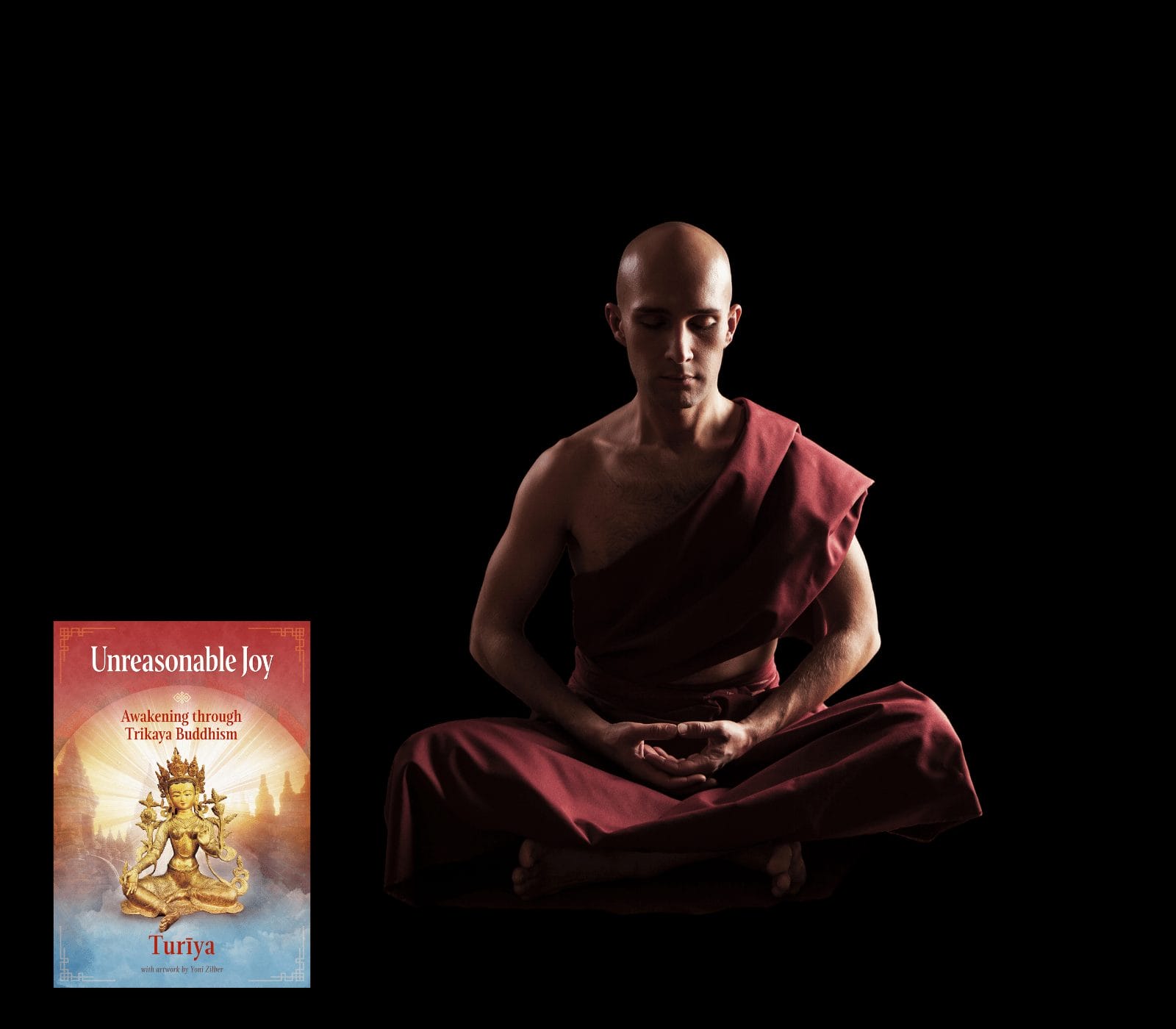AWAKENING THROUGH TRIKAYA BUDDHISM

Being Aware of Trikaya Buddhism
Turya is a Buddhist monk, teacher, and author who, despite living with chronic pain, founded the Dharma Center of Trikaya Buddhism in San Diego in 1998 to share her path. For over 25 years, she has taught thousands of students how to meditate, trained teachers, and helped people discover the unreasonable joy of our true nature.
Turya believes that Enlightenment is real and exists right now, within us all. In this Om Times interview, she shows how this innovative form of Buddhism, which she has been developing in the United States for over 25-years, can point the reader toward Enlightenment and liberation from suffering.
INTERVIEW WITH TURIYA – ABOUT UNREASONABLE JOY – AWAKENING THROUGH TRIKAYA BUDDHISM
OMTIMES: You have developed a new school of Buddhism; can you tell us how it came about?
TURIYA: My teacher showed me a pure and direct path of Awakening. After he passed away, I wanted a community to continue my practice with. I spent time exploring all the Buddhist schools I could access, but none felt like home. I opened the Dharma Center. Over the years, this new school developed as I watched what practices worked in our society and what did not. As Buddhism became more popular, we realized we needed to name this type of American Buddhism to differentiate it from the other schools. We decided on Trikaya Buddhism because the name symbolizes the embodiment of Enlightenment in the world.
OMTIMES: What are the essential differences in your school of Buddhism to those currently available?
TURIYA: Trikaya Buddhism is thoroughly American-born. As far as I know, all of the other Buddhist schools being taught in the United States carry with them the culture of their founders.
Many of these cultural artifacts are beautiful and beneficial, but they don’t necessarily have anything to do with Enlightenment. Trikaya Buddhism is naked Buddhism; it’s stripped down to the bare essence of meeting the mind wherever we are. Some key differences that might confuse some traditional Buddhists are we have female monks.
When the Buddha created a monastic order, he was already pushing the boundaries of his society. Because of the limitations of his time, he put women a step below men. In Trikaya Buddhism, we recognize in terms of buddha-nature, there is no difference between women and men.
Thus, we give ordained practitioners the same title of a monk. Another big difference is we focus more on internal renunciation than external renunciation. It means our monks decide for themselves if they can be married or celibate or not.
OMTIMES: You have been a meditation teacher for over 25 years – well before it became popular and prescribed by medical practitioners as stress relief. How has it changed your life?
TURIYA: Meditation not only changed my life, but it also saved my life. Before I got sick, my practice opened me to a world of endless possibilities. Even though I had been told I could do anything, in college, I felt stuck. I couldn’t see beyond a dreary existence of work, eat, and sleep. Meditation introduced me to the beauty and joy that is present every moment. It gave me the energy to creatively interact with the world and build the life of my dreams.
When my body started collapsing, meditation allowed me to keep my sanity. It gave me the power to keep looking for answers to my medical issues. Because of my meditation practice, I realized that joy is entirely unreasonable. Even when the body is screaming in pain, there is peace.
There were times when I wanted to die, but my spiritual practice gave me proof that we are more than these fragile bodies. By teaching on the days when I could barely get out of bed, I discovered I had a gift to offer others simply because I knew how to meditate and silence my mind. People would arrive at the Dharma Center with their suffering. By sitting with them for an hour, I discovered my pain would disappear for that hour, and they would be elevated into a place where they could see past their issues. Watching this happen over and over transformed my awareness and allowed me to develop a strong faith in the practice.
OMTIMES: You declare that Enlightenment is real, and, in your book, you describe your experiences – please explain to the reader what they will experience through Trikaya Buddhism
TURIYA: Through Trikaya Buddhism, we move beyond suffering. At the beginning of the path, we learn how to control the mind through meditation and mindfulness. As we continue, we learn about the games we run on ourselves, and we start to see all the ways we have attached our happiness to an outcome. Through more subtle meditation and mindfulness techniques, we discover how to let go of these attachments. In the more advanced stages, we surrender to all that is. While it’s tempting to jump to the end of the path, we have to remember that if we don’t have control, then we cannot really surrender.
OMTIMES: You believe that the real test of wisdom is its practical application in the here and now – can you explain what you mean?
TURIYA: When we spend time alone or limit our interactions with others on our path, we can fool ourselves into thinking we have discovered our innate wisdom. We can feel like we are free when we are not. By going out into the world and being of service, life has a way of revealing to us all the ways we are still hung up.
For example, we could realize that anger is a passing emotion we do not need to act on. By interacting with people outside of our circle, on social media, perhaps, we can watch when anger arises within us. If we start ranting in reaction to that anger, we have not yet earned the wisdom we have been shown. On the other hand, if we notice our anger, accept that it is present, and then choose to act with gentleness, we have proven that we know we do not have to identify with anger. We can watch as it arises and watches as it dissolves, without denying that it exists.
OMTIMES: What do you mean by “true nature?”
TURIYA: Our true nature is who and what we are beyond all the labels and conceptions we have about ourselves and the world. We cannot define our true nature, but we can point towards it. When we feel free, limitless, expansive, joyful, and at peace, we are in tune with our true nature.
OMTIMES: The book contains some beautiful pieces of artwork – why was it important to include them in the book – how do they help the reader connect with the teaching?
TURIYA: Buddhist art, and especially Tibetan thangka art, is more than creative expression. The images are meditation tools. They have been passed down through generations of Tibetan Buddhists who have been trained in geometric precision and exacting detail. When this art is created, the artist enters into a meditative state. It allows them to put every line and dot in perfect order.
The energy of this meditative state is held by the artwork, so when we gaze at it, we can easily slip into meditation.
Most of what I teach cannot be put into words. By including this sacred artwork, the reader slows down, and if they let their mind rest on it, more of what is being shared in the book can come through.
OMTIMES: What is a “Mindstate”?
TURIYA: A Mindstate is how we hold our mind at a particular moment in time; it’s the mental filter we create. Our thoughts and feelings come together and cultivate a mind state, which then colors our perception of the world.
For example, we might see a news report about a tragic story that makes us angry. Left unchecked, we enter into a mindstate of anger. Now, as we go about our day, our mind filters the world and shows us all of the other things that make us angry and frustrated.
It reinforces this mindstate of anger. We stay stuck in this cycle of anger until something shifts us into a different mindstate. We can shift ourselves consciously by focusing on beauty or gratitude. But most people are unaware of their own mindstates and are tossed around by their external world. They might stay angry until someone gives them some good news, and then they will be happy until they hear some bad news.
OMTIMES: You write about psychic sensitivity and inaccessibility. Can you explain why it was important to include this chapter?
Psychic abilities are not unique. We all have them, but most people have been trained to ignore them.
However, when we practice meditation and mindfulness, our awareness expands, and we start to feel the subtle layers of existence. If no one points out what is happening, it can be very disconcerting and confusing. I’ve had students become so sensitive they had trouble going to work and being in the world. Rather than sequester them, I teach them how to manage this increased awareness. Ultimately, we use psychic sensitivity to become more compassionate. What I call the practice of inaccessibility allows us to work with our sensitively to teach us where we are attached. Once we see where we are getting stuck, we can let go of our ego’s desire for things other than they actually are. From this space of non-attachment, we can be of service by doing whatever is most beneficial for all beings.
OMTIMES: Finally, what else would you like the reader to take away from reading your book?
TURIYA: What I want most for readers is for them to feel empowered to begin the practice on their own. We can listen to thousands of teachers, but it’s all meaningless until we actually do the work. I hope the book inspires them to practice at home. When they are ready to find a group, whether that’s at Dharma Center of Trikaya Buddhism or elsewhere, where they can continue to refine their practice and explore the excellent path of Buddhism.
OMTimes is the first and only Spiritually Conscious Magazine.
Follow Us On Facebook, Twitter, Instagram, Linkedin, Pinterest, and Youtube
Creatrix from Sirius. Fairly Odd Mother of Saints (Bernards). Fish Tank aficionado by day ninja by night. Liane is also the Editor-in-Chief of OMTimes Magazine, Co-Founder of Humanity Healing International and Humanity Healing Network, and a Board Member of Saint Lazarus Relief Fund.




